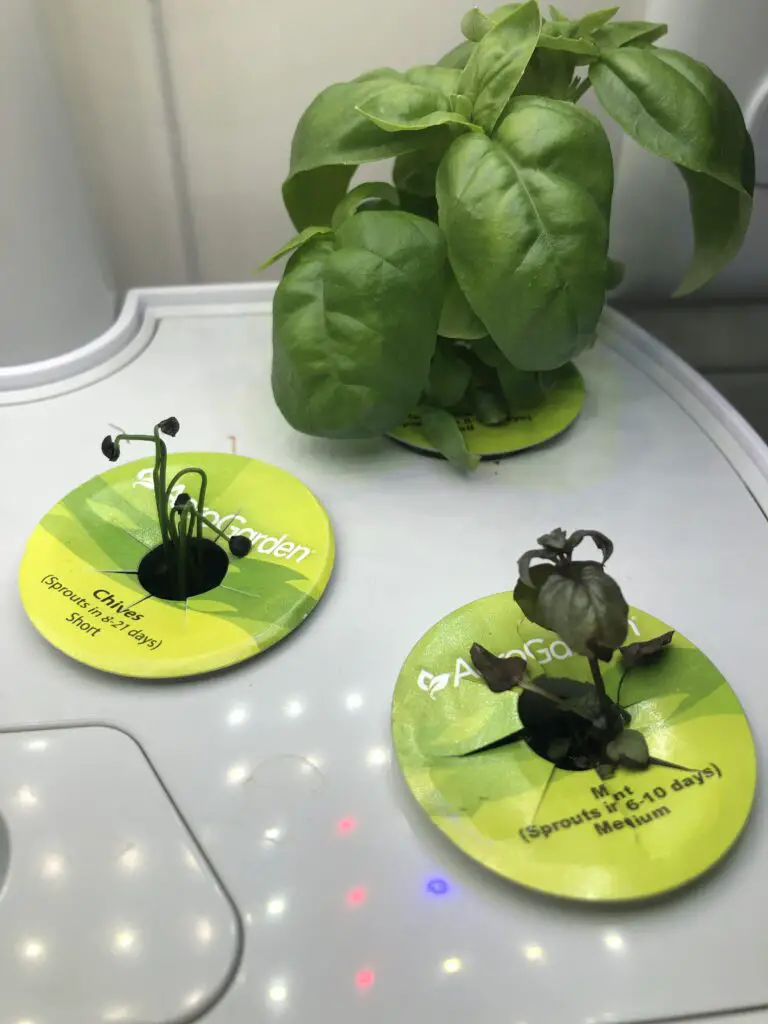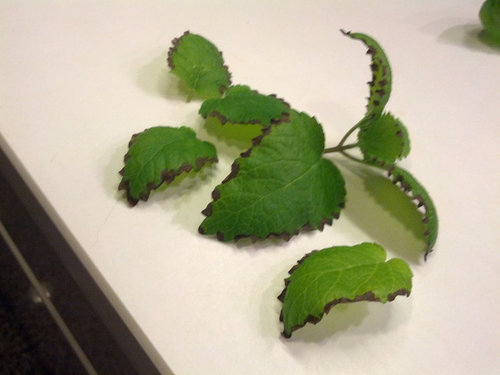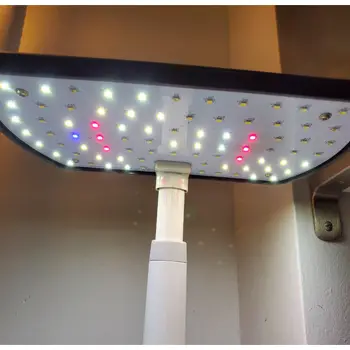Disclaimer
Hi, just letting you know that all products recommended here have been used by me, or are properly researched to ensure they are the best you are getting without bias.
I am also an affiliate for certain Amazon products and this means that some links here are affiliate links. If you purchase an item through any of them, I MAY earn a commission at no extra cost on you.
Mints are very popular herbs all over the world particularly for their menthol flavour and fruit-like scents, which are easy to grow and can develop very fast too. However, their leaves can turn brown for a myriad of reasons. Leaves can easily become yellow or brown in some instances, where essential nutrients are not readily available. In the same vein, lack of enough water or excessive heat can blight the leaves too. In the case of mint leaves growing in aerogardens, they mostly turn a brown colour if the water provided for the plants contains too many dissolved minerals. Sometimes, if the seed kit in the unit has been used to grow plants for a long time without either a rinse or a refill, it can discolour the mint leaves.
quick answer:
In a nutshell, any imbalance in nutrients can manifest as dark-yellowing of the leaves or the browning of its edges. If this poor development is not promptly addressed, you risk losing the plant altogether. In some instances, the positioning of the brown colour on the leaves itself may be indicative of the cause. Whenever the brown colour is on the inner surface of the leaf, it is an indication of either overwatering the plant or even poor drainage. On the other hand, if the brown colour is at the tips of the leaves, it is symptomatic of pest infestation or even the presence of a fungal disease.
Browning of leaves can also be secondary to external factors as well, such as excessive heat or salt accumulation, or even both. In this post, you will learn all you should know about mint leaves turning brown in your aerogarden, causes, solution and other helpful hacks that would come in handy.
What causes my aerogarden mint leaves to become brown?
Aerogarden mint leaves browning can be caused by any of several factors, some of which are:
- Overwatering: This is simply saying that when the plants are literally drowned in water, just like humans in large water bodies, they can become brownish in response.
- Poor water draining: When you leave the same water too long in your aerogarden without changing it regularly, you risk contaminating your mint leaves and this may get them to turn brown.
- Fungal disease: Plant diseases that are caused by fungi can cause the browning of leaves in the plants too. These fungal diseases include Web Blight, Mint Rust, Pest Infestation, Two-spotted Spider attack on the leaves, infestation by aphids (a kind of fly), four-lined plant bugs, salt, over-fertilization, root overgrowth, even light burns, and more.
- Unbalanced nutrients: Every plant nutrient or mineral salt has its uses in the plant and when the said substance is missing or in some instances oversupplied, the leaves are usually the first to show the signs of this deficiency. For mint leaves, this can get the leaves turning brown. When you are adding nutrients to your aerogarden plants, if you do not follow the required measurements for each plant time, it can cause different issues for your plant and this include the browning of the leaves.
- Undissolved minerals: If your plant food involves more minerals, having some of them in the aerogarden water and staying undissolved for long, especially when the minerals are too much. may lead to your leaves browning. especially mint leaves.
How can I fix my brown mint leaves?
Fixing the brown mint leaves may not always bring permanent results but it can control it and manage the situation. When you start noticing brown mint leaves growing on your aerogarden, you can try some of the below solutions to fixing brown mint leaves in aerogarden:
- If you happen to observe any sudden browning of the leaves, you should first find out whether the plant is too clipped or even soggy. In such a situation, you should consider changing the water, adding the proper quantity of water and setting the water pump settings to the right flow rate.
- If the water is not the problem, check the nutrients to be sure you are using the right one, and that they have not expired or gotten spoilt at some point. If this is the case, you need to get the right nutrient for your leaves and stop using the other.
- It would help to regularly check that you are giving your plants enough nutrients. You can get a PPM meter to help you monitor your nutrient level so you do not give them less.
- To keep your plants safe from pest infestation, you can use pest traps or very mild sprays. For a natural approach, mix Garden Vinegar and water in a spray bottle. The best way to reduce the potency of the solution is by making the vinegar and water to be in ratio 3:1 respectively. Spray this mix over your plants carefully; it can help keep some of these crawling things away and won’t harm the plant or you later on. You may opt to use any safe plant pesticides or insecticides spray that is not injurious to human and plant health in eliminating these insects. Like this Houseplant & Garden Insect Killer. An insect sticky traps can also come in handy as they are usually brightly coloured with glues that will draw in flying insects, trap them and control any infestation.
- Should you observe that the problem is due to excessive water supply, you should see that the plants are irrigated less to guard their roots against decaying.
- Note that if the leaves are browning only on one side, try cutting off the entire branch where those brown leaves are growing and see if it stops the spread.
If you have tried all these and the brown leaves are still spreading, the leaves may have gone beyond fixing. For this you may just have to start a new planting circle.
Quick solution for brown aerogarden mints leaves
Let’s take a look at the common reasons for this mint leaf discolouration and possible quick solutions:
1. Overwatering and/or excess minerals are some of the causes of mint leaves turning brown. To solve this problem, you can remove the plant tray, empty the water in which the plant grows, fill the unit with water again, dip the roots of the plant back in the water, remove and empty the water. Repeat this before giving the aerogarden a thorough rinse and pouring the right quantity ofwater and setting the tray back in. Notably, in this procedure, about six inches of water can reduce excess minerals/salt in half. You can repeat the process above several times for a more satisfying result. Just be careful with the roots.
2. Root overgrowth is another cause of this. These plants are renowned for the invasive and very aggressive spread of their roots, which is why they are commonly raised in containers to curtail this root invasiveness. Excessive growth can reduce the absorption of water, oxygen, and other plant nutrients which they require. When the supply of necessary nutrients is limited, their leaves begin to turn brownish. In such a situation, the roots will begin to grow over one another. If you observe this, start to split them apart from the main plant and transfer some of the overcrowded plants to another aerogarden or growing pot entirely. This would prevent the roots from choking themselves up, and by extension choking the entire plant as well.
3. Severe heat is capable of causing burns on the leaves, thereby leaving them brown and very wilted too. Although mints are known to love heat, they do not like when it is scorching heat like the midday sun or very bright grow lights. To solve this problem, keep the light at the right setting and avoid keeping it under very hot sun.
What to do to stop aerogarden mint from turning brown again?
- Mint leaves turning brown is due to the prevalence of certain conditions among which are waterlogging, severe heat, among others. To prevent their leaves from becoming brown again, you should always ensure that you regulate their water availability and intake very well so that over-watering will be prevented.
- Where the plants are expected to suffer from burn, it is good to place and raise them in an area where very severe heat will be avoided.
- In the case of fungal attacks, you should routinely get them treated with natural sprays (Garden Vinegar and water), insect sticky traps or pesticides.
- Monitor their roots closely, and if you observe any sign of root overcrowding, simply transfer some of the plants to another pot entirely, this will check the plant roots from growing on top of one another to the detriment of the plant itself.
Can I eat my harvested aerogarden mint leaves that have turned brown?
Mint leaves turning brown can be consequent upon a fungal disease, which means that you really shouldn’t eat them for whatever reason. On the contrary, if the browning of the leaves is due to either extreme heat or overcrowding, there is no problem, you can eat them provided the leaves are treated properly.
Similarly, any mint plant that has been infected with rust is not supposed to be eaten too for obvious reasons. In most cases, the leaves may eventually die and fall off the plant, which will make them stunted.
What happens if I eat mint leaves from my aerogarden that have turned brown?
Since browning of mint leaves is attributable to several factors, it becomes clear that when these abnormal colour changes are due to such conditions as extreme heat, waterlogging, or the availability of too much salt in the plant, you can treat the leaves very well and consume them without any fear of any infection.
However, when you eat those brown mint leaves from a plant that has suffered from any fungal infection, chances are that you may wind up with an infection from the fungi as well. To avoid this, make sure that you verify with absolute certainty what has caused the leaves to turn brown. Despite this, treat the brown leaves before eating even if the colour change is due to any harmless causes.
Conclusion
With the right knowledge of how to both identify the causes and also how to remedy the brown leaves of mint, you will have almost nothing to worry about.
Remember it is not a good idea to eat any mint leaves known to come from an infected plant, and even when the brown leaves come from an uninfected plant, they must not be consumed without proper treatment.





